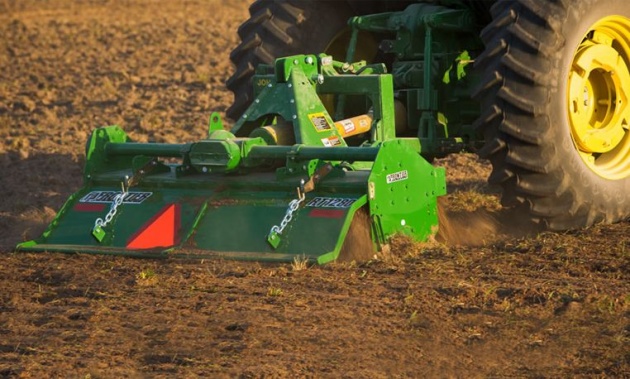A rotary tiller is a specialized mechanical tool used to plough the land by a series of blades which are used to swirl up the earth (Hendrick and Gill, 1971c). Nowadays, utilization of rotary tillers has been increased in agricultural applications because of simple structure and high efficiency for this type of tillage implements. By taking advantage of rotary tillers, the primary and secondary tillage applications could be conjugated in one stage (Topacki et al., 2008). Rotary tilling is a widely used tillage operation in Indian farming because of its superior ability to mix, flatten and pulverize soil. However, the use of rotary tiller is strongly restricted to "shallow" tillage because of its high energy requirements. Deep rotary tillage using less energy has recently become a subject of wide interest to combat soil fatigue caused by excessive use of chemicals among other reasons, and to convert paddy fields into dry fields such as kale fields. Despite of their high energy consumption, since rotary tillers have the ability of making several types of tillage applications in one stage, the total power needed for these equipments is low (Culpin, 1981). Because rotary tillers power is directly transmitted to the tillage blades, the power transmission efficiency in rotary tillers is high. Moreover, the negative traction existence in rotary tillers causes the required tractive force to be decreased and consequently, smaller tractors could be used with this type of tillage implements for land preparation. Power to operate the rotary tiller is restricted by available tractor power (Yatsuk et al., 1981; Srivastava et al., 2006). The rotating blades chop and mix the residues evenly throughout the working depth, outperforming any other implement.
During tillage with a rotary tiller, almost 50% of total energy consume in the farm, so it is necessary to optimize the force requirement for tillage operation. Again at different moisture content soil strength is different. If soil strength is more than force requirement for tillage operation is also more. So it is necessary to select a optimize moisture content and soil strength so that force requirement for tillage will also be least.
Generally in the field the moisture content varies throughout the entire field as it is not under controlled. But in a soil bin moisture content can be controlled as per the requirement. The water content of the soil is an important property that controls its behaviour. Usually, the soil parameters in soil bins such as variation of cone index and soil compaction level are more constant (Naderi et al., 2009). As a quantitative measure of wetness of a soil mass, water content affects the level of compaction of soil, which is indicated by its bulk density. Soil bulk density is an indicator of the degree of compaction in engineering construction works. The desired value of bulk density varies with the degree of stability required in construction. Bulk density is also used as an indicator of problems of root penetration, soil aeration and also water infiltration. The cone index of a soil which is the degree of its strength has been shown to be affected by its water content and bulk density.
In the past, a number of studies were conducted to design suitable blades of rotavator in order to reduce the energy and power consumption (Shibusawa, 1993). In an experiment in a soil bin, Gill and Berg (1968) observed that tool draft varied with the tool traveling distance. Siemens and Weber (1964), Stafford (1979), Durant et al. (1980), Godwin et al. (1980), and Onwuala and Watts (1989) made some small-scale soil bins whose length ranges from 5 to 13 m, and test speed of up to 5.5 m/s for a total working length of 10 m.
Upadhyaya (1986) developed and used soil bins to study basic soil Machine. Wismer (1984) states that there were about 36 different facilities in 12 countries that had 90 soil bins constructed. Wood et al. (1983) and Onwualu et al.( 1998) states that there may have been about 150 soil bins in use around the world with only several new soil bins built since 1983. So it appears that no work has been reported on the soil-blade interaction for a rotary tiller in a controlled soil bin. Hence this research work was undertaken to investigate the soil-blade interaction and to predict the effects on penetration force and toque while soil cutting through a rotary tiller blade in a controlled soil bin.




